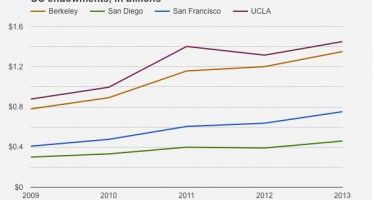Legislative transparency bill shelved again
Congresswoman Nancy Pelosi was mocked for saying about the Affordable Care Act, “We have to pass the bill so that you can find out what is in it away from the fog of the controversy.” But that type of legislating-in-the-dark is too often the norm in California, according to Assembly Republican Leader-Elect Kristin Olsen, R-Modesto.
“You may remember in 2011 when the education bill trailer language was passed. And we actually received the language of the bill 15 minutes after the vote,” Olsen reminded the Assembly Budget Subcommittee on Budget Process, Oversight and Program Evaluation. “That’s just unacceptable. How can we possibly be expected to make wise decisions if we don’t have an opportunity to review the language?”
Olsen appeared before the committee on May 7 to introduce Assembly Constitutional Amendment 1, which is designed to increase transparency in the legislative process. The bill, according to the committee’s legislative analysis:
- Prohibits either house from passing a bill unless it has been made available in print and on the internet for 72 hours prior to the vote.
- Provides an exception for urgency bills related to a declared emergency, as specified in the Constitution.
- Allows bills to be heard by committees after the contents of the bill have been available on the internet for 15 days.”
Relegated to suspense file
ACA1 is Olsen’s fourth legislative attempt to increase transparency. But the bill has met the same fate as her three previous efforts, which were relegated to the committee’s suspense file, never to be voted on and dying at the end of the legislative session. Olsen made her best case for the bill in her remarks to the committee:
“This bill will allow legislators to thoroughly analyze measures before voting. It will end the midnight votes on last-minute, backroom deals, and it will bring greater transparency to the lawmaking process. It would also allow stakeholders’ time to voice their concerns or support.
“I would remind all of us that this bill doesn’t require anything that isn’t already required of cities, counties, special districts, school boards, etc. Simply put, Californians should be given the opportunity to review all bills before they are voted on. As legislators we should be given adequate time to analyze a bill in order to make a sound decision.
“In 2011, 48 bills were completely rewritten in the final weeks of the session. Of those bills, 22 made it to the governor’s desk. He signed all but three of them. In 2011, 36 percent of the approved bills passed through the full process. And yet, bills that were gutted and amended and rushed through the process passed at a higher rate of 46 percent.
“In 2011, SB202, a bill that changed the initiative process, was gutted and amended on September 8 and was voted on the very next day after a 13-minute hearing that was scheduled only two hours before the hearing took place. The very next day, SB202 passed the Senate and was sent to the governor. All of this happened in a 48-hour period. People did not have the time to engage, to analyze the bill. We really didn’t know what we were voting on in terms of the details.
“Examples like SB202 send a bad message to the public and contribute to cynical attitudes toward the Legislature. It’s really not a partisan issue. As Republicans and Democrats, we would do a great job working together to increase trust in government by simply allowing bills to be in print for 72 hours.”
Olsen cited a recent poll by the Institute for Advanced Technology and Public Policy at Cal Poly San Luis Obispo that showed 89 percent support for a 72-hour wait period before voting on legislation.
Legislature should play by same rules as local governments
California’s cities agree that state government should play by the same transparency rules that local governments must follow, said Dan Carrigg, legislative director for the League of California Cities. He told the committee:
“It bewilders [city officials] when they observe or hear about proposals in the Legislature that can move very quickly without the transparency that you expect of them through your laws such as the Brown Act and other things that apply to us.
“A couple years ago a number of cities were severely harmed by the passage of SB89. That bill took away vehicle license fees from cities. There had been special allocations that helped cities with annexations as well as new incorporations. The law that established those special allocations went through the Legislature in a very deliberative process. It was crafted, refined, amended.
“The bill that took it away without a public hearing probably went through the building in about six hours. So those that were affected by the law never had a chance to, one, even know about it, and two, be able to even talk to the legislators and make sure the legislators knew what the full impacts were. So that’s why our membership feels that having an in-print rule would improve the process.”
Time needed for in-depth look
Also urging passage of ACA1 was Nicolas Heidorn, representing Common Cause. “As legislators we think you’re asked to do something which is challenging if not impossible,” he said. “Which is when a major policy revision is dropped in your lap at the last minute, to ask you to vote on this without having had the time to really look in depth at the bill.
“We also think that the Legislature does itself a disservice when there isn’t the time for public input to look at the bill and provide you with recommendations and thoughts, which can help act as a safeguard to prevent errors in legislation or unintended consequences. This bill is important to stop special interests from inserting at the last minute provisions that might harm the public interest that the Legislature and public don’t have time to analyze and catch.”
Heidorn pointed out that other states have implemented similar transparency provisions in their legislative process. “Michigan for over a century has had a five-day print rule,” he said. “Hawaii has a two-day print rule. Florida has a 72-hour print rule for appropriation rules. So we think there’s ample evidence in other states that the process can work.”
Thurmond raises concerns
No witnesses spoke in opposition to the bill. But concerns were raised by one committee member, Assemblyman Tony Thurmond, D-Richmond. “I’m torn because I really value the goals of transparency,” he said. “Like many [in the Legislature], I come from local government. The Brown Act was something that was imbedded into my kind of being about how we make the public informed about anything that might be voted on. I support the goals of transparency.
“I’m also a person who loves always having some flexibility for situations that might arise that we cannot anticipate, and would be concerned about government’s ability to have those flexibilities to do business that meets the needs of the people. The drought package was a perfect example of our ability to act, recognizing that so much of what was in that package is going to take start-up time and ramp-up time. And that because there are communities with no water and because there are communities that have even just one year’s supply, we need as much ramp up time to move.”
Olsen responded, “We do have the exception in there if the governor declares a state of emergency we can certainly act within less than three days. The drought would be a great example where he could and has declared a state of emergency.
“But even in the package of bills this year, nothing would have been harmed had we voted on the drought relief package on Thursday instead of Monday. And as evidence of that I would point to the fact that the drought relief package we passed a year ago, most of the funds still have not been allocated and spent. So there’s nothing so urgent that three days couldn’t accommodate the need to be able to still pass that very important and critical piece of legislation.”
Committee Chair Shirley Weber, D-San Diego, began the hearing by announcing that “Budget Sub 6 was created in 2011 to consider changes to the budget process and bills related to the budget that were proposed by members. All non-committee bills referred to Budget Committee are heard in Sub 6 and referred to suspense automatically without a vote similar to the way it’s done in Appropriations.”
Olsen pleads for ‘true representative government’
After Weber sent ACA1 to the suspense file without a vote, Olsen made a plea for its passage this time around. “The public deserves full disclosure and timely and accurate information from their elected officials about how their taxes are spent, just as we require of all municipal governments,” she said. “Only then can we claim to have a true representative government where people have the ability to voice their opinion on all issues. Our constituents deserve better from us.
“And at the very least they deserve a vote on this measure. In 2013 I had ACA4, and that was the third version. This is now the fourth time I’ve introduced this. ACA4 came to this committee, it was placed on suspense, it never got an up-or-down vote. My question is, when does the suspense file get voted on? In Appropriations Committee, in Rev[enue] and Tax Committee there’s always a hearing where the suspense file gets voted on. And I think ACA1 deserves the opportunity to actually receive a vote. I would appreciate being noticed when this budget committee plans to take up that suspense file for votes on each of the bills.”
Weber did not respond to Olsen’s request, saying simply, “Thank you,” then moved onto the next agenda item.
Olsen expressed her frustration in a press release on her website:
“While I appreciate the discussion we had about legislative transparency, today’s hearing was really just talk. I am disappointed that my Democratic colleagues did not allow an up-or-down vote on my bill. Year after year, efforts to shed more light on lawmaking are shelved by the majority party without a vote. This adds to the cynicism of Californians who feel shut out of their government.
“Too much of what goes on in Sacramento happens in the middle of the night, when the public isn’t watching. This is not healthy for our democracy. It’s time to modernize the legislative process and end the back-room thinking that dominates too much of what goes on at the State Capitol. By making legislation available online at least 72 hours before a vote, the public can engage in the process and make their voices heard.”
Related Articles
Wall Street Journal too nervous about bullet-train ruling
Over the weekend, the Wall Street Journal’s editorial page continued its excellent coverage of California issues with an editorial (behind
UC endowments soar as tuition hikes continue
While families struggle to help students with tuition — and as student loan debt skyrockets — California universities continue to
LAO report: Dozens of school districts not honoring intent of state law
The state Legislative Analyst’s Office released a report last week on how 50 California school districts were dealing with the





